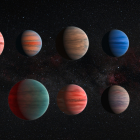How many people would it take, at least, to start a thriving colony on our neighboring planet Mars? It seems to be less than we imagined. As we consider the possibility of one day sending humans to Mars and then, in the future, create a colony, Scientists are exploring ways to overcome obstacles that stand in the way of achieving these goals. One factor that must be addressed is precise identification How many people could support a colony on Mars and what kind of people would be needed.
Now, a team of scientists at George Mason University has discovered the minimum number of people needed to operate a long-term settlement on Mars, and The magic number is only 22 people. The scientists published a study describing their simulation on a preprint server arXiv Which has not yet been peer-reviewed.
This is the number of people it would take to build a colony on Mars
The researchers used a computer program known as Agent-based model (ABM) – a computer system not unlike a large video game – to predict how many people would be needed to maintain a colony on Mars. The model analyzed four personality types: Fun, without being too competitive or aggressive; Sociable people, extroverted people who function very well in social settings; Reactive, who struggle to adapt to changes in routine; Neurotic people are very competitive and certainly aggressive people. Later, computer simulations varied the number of each type when performing key tasks.e such as mining and farming in a hostile environment like Mars. Among the simulations, there was the situation that the colony had already been built and that food, air and water could be produced locally, and that energy was also generated on the planet, for example including human social and psychological behavior as well. Like the harsh landscape of the Red Planet.
“Each agent is given skills related to his or her civilian and military occupational specializations consistent with NASA research on human factors and components of behavioral performance, which has analyzed which skills can be generalized across conditions,” the authors explain. Ones that would be needed by all crew members during a 30-month expedition to Mars“.
This is how artificial intelligence imagines a colony on Mars
What is the survivability of the colonists?
The simulations have been run for 28 years With varying numbers of people starting colonies, between 10 and 170 people. They analyzed previous data on high-performance teams located in remote, high-stress environments, including submarines, Arctic missions, warfare, and the International Space Station. Based on the results of the simulations, scientists reached two main conclusions: that Only a few dozen initial settlers were needed to establish a sustainable colony (22 was the minimum number needed to maintain a colony), and people with more agreeable social traits did better for themselves and for the settlement as a whole.
“We found that an initial population size of 22 is the minimum required to maintain a viable colony size over the long term. We also found that an agreeable personality type is the most likely to survive,” the experts noted.
These results contradict other studies that indicated that between 100 and 300 people would be needed to establish the first sustainable colony on Mars. But either way, neither human nor computer simulations of Mars missions can fully predict the experience of placing a colony of humans on the Red Planet, but they are pages in a book that can continue to be expanded with new data until the truth arrives. In the future, experts intend to add new methods to close the circle of ideal settlement on Mars.without the problems of inbreeding, for example, as might occur in this case.
References:
- Edgar Arguello et al., Exploring Mars Colonization Using Agent-Based Modeling, arXiv (2023). doi: 10.48550/arxiv.2308.05916
- Azua-Bustos, A., Gonzalez-Silva, C., Fernández-Martínez, M., Arenas-Fajardo, C., Fonseca, R., Martín-Torres, F., Fernández-Sampedro, M., Verín, A. . ., and Zorzano, M. (2019). Aeolian transport of viable microbial life across the Atacama Desert, Chile: implications for Mars. Scientific Reports, 9. https://doi.org/10.1038/s41598-019-47394-z.
- Chen, M., Goyal, R., Magee, M., and Skelton, R. (2020). Design and analysis of a viable artificial gravity space habitat. Aerospace Science and Technology, 106, 106147. https://doi.org/10.1016/j.ast.2020.106147.
- Horgan, B., Anderson, R., Dromart, J., Amador, E., and Rice, M. (2020). Mineralogical diversity of Jezero crater: evidence of possible lacustrine carbonates on Mars. Icarus. https://doi.org/10.1016/j.icarus.2019.113526.
- Grady, M. (2020). Exploring Mars with returned samples. Space Science Reviews, 216, 1-21. https://doi.org/10.1007/s11214-020-00676-9.

“Beeraholic. Friend of animals everywhere. Evil web scholar. Zombie maven.”


